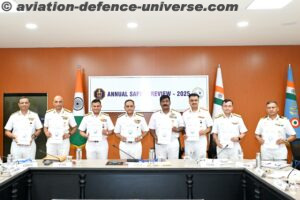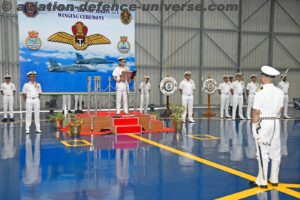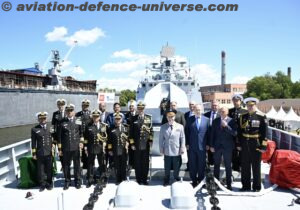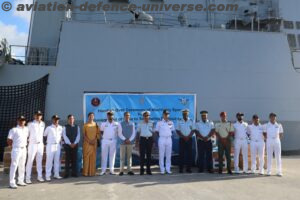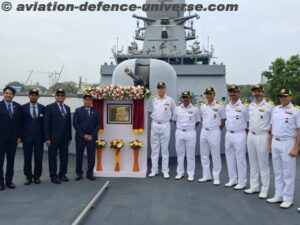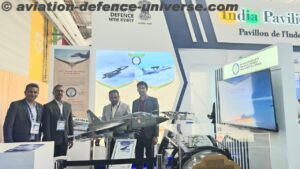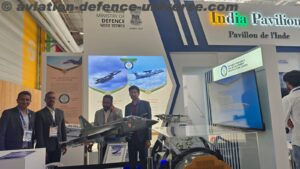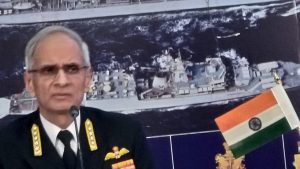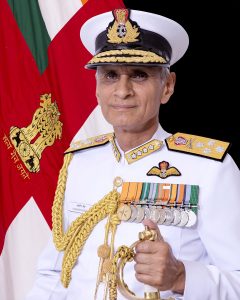
- Indian Navy celebrates 48th Navy day on December 04
New Delhi. 04 December 2019. “Indian Navy aims to be a balanced multi-dimensional force with modern surface, sub-surface and air assets, capable of blue water and littoral operations in the Indian Ocean Region and beyond to protect and promote our national interests,” stated Admiral Karambir Singh PVSM,AVSM, Chief of Naval Staff, India in an exclusive interview to Aviation & Defence Universe (ADU).
ADU. The Navy has a very focussed long, medium and short term plan based on the threat perception and capability enhancement and budgetary allocation. Given the constrained budgets and increasing operational tempo, what are the priority areas you will focus on from a combat and surveillance capability perspective?
CNS.The plan for the Indian Navy is fundamentally capability driven, with threat perceptions, prevailing external security environment, emerging technologies and availability of funds, being concurrent drivers.
The present force levels are being augmented/ modernised to sustain the full spectrum of roles and tasks defined for the Indian Navy. Our efforts are focussed on a combat ready, technology enabled and networked force, capable of projecting combat power. Consequently, we seek to evolve relevant doctrines and conceptual frameworks, in order to acquire war-fighting capabilities to operate across the full spectrum of conflict in support of our national interests.
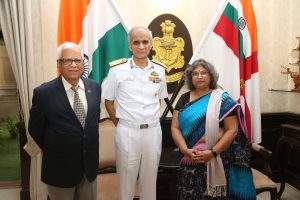
ADU. The diminishing submarine capability has dogged the Navy for some time notwithstanding Arihant, Kalvari and the Life extension programmes for some of the older submarines. The delays in delivery of the French Scorpene submarines being built at MDL are further eroding our undersea warfare capability, The P75 (I) programme is still many years away. How do you propose to address this critical shortfall in the medium and long term?
CNS. The required force levels of our submarine and strategy of their operation in the future have been enunciated in the overall force structure plans and are being developed to address the challenges in the underwater domain.Indian Navypresently operates fifteen conventional submarines (09 Sindhughosh Class, 04 Shishumar Class and 02 Kalvari Class) and one SSN. With a mix of conventional and nuclear submarine, the Indian Navy’s submarine arm is capable of accomplishing a wide range of operational tasks. Most of our submarines have been modernised and upgraded in term of their weapons-sensors suite as well as their crew-support system. INS Kalvari and Khanderi, two Scorpene class submarines have been inducted into the Indian Navy. The balance four Scorpene submarines are at various stages of construction and trials at M/s Mazgaon Docks Limited, Mumbai.
Further, the case for procurement of six submarine under Project 75(I) is being actively pursued under the Strategic Partnership model. This would provide a fillip to indigenous submarine construction under the ‘Make in India’ initiative of the Government of India (GoI). Shortfalls in ‘Force Level’ will have to be addressed by the GoI through speedy implementation of Project 75(I).
ADU. Is Chinese investment in Pakistan and Sri Lanka ports thereby maintaining its presence in India’s vicinity a challenge for the Navy? Will Indian Ocean and South China Sea become Navy’s main beat areas?
CNS. We are closely watching developments in relation to China in the region. The commissioning of the Chinese Military Base at Djibouti in 2017 has augmented its sustenance capability in the Indian Ocean. In 2018, an average of seven PLA(Navy) ships and submarines were deployed in the Indian Ocean Region every month. Chinese investments in various projects across IOR are also known.
The Indian Navy is aware of the security implications of the enhanced presence of Chinese ships and submarines in the Indian Ocean Region and maintains a constant and close watch on such developments. We are assessing our concept of operations and acquisition plans to cater to the challenges. The operational outcomes of developing strategic imperatives in the IOR are factored in our planning to ensure that the Indian Navy remains poised to meet all maritime contingencies.
ADU. The IFC-IOR is one year old. It is a major Force Multiplier for MDA in the IOR. How much has it progressed and is it now operating at its full potential?
CNS. In a short span of a year, the IFC-IOR has emerged as an important regional hub for collating and sharing white shipping information. The centre has been interacting with 18 countries and 15 maritime security centres. IFC-IOR also conducted a Maritime Information Sharing Workshop (MISW) in June this year which was attended by 41 delegates from 29 countries. The centre would shortly commence hosting International Liaison Officers (ILOs) from partner countries. We are also progressing the case for augmenting infrastructure to create a full-fledged IFC-IOR, so as to enable ILOs from a larger number of IOR nations to interact and contribute to the initiative.
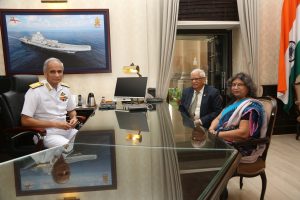
ADU. Navy’s indigenisation plan has definitely made it the trailblazer in the forces. But the fight component is very heavily dependent on imports. How do you plan to change that? And along with this how do you plan less dependency on PSUs and involve the private sector more?
CNS. Indian Navy has always laid emphasis on self-reliance and indigenisation at every level. The vision of the naval leadership over the last many decades has been to become a ‘Builder’s Navy’. The dependency of fight component on imports has already reduced considerably, for example, in case of Kolkata Class ships. In this particular class, weapons and sensors are all indigenously produced. The Surface-to-Air Missile (SAM) complex for the ship has been jointly developed by M/S IAI and DRDO/BEL/BDL. Weapons and sensors onboard P 15B and P 17A ships are also going to be on the same lines. So, it would be apt to say that Indian Navy has been successful in progressively achieving high levels of indigenisation in fight component as well.
Participation of private sector is being encouraged under the aegis of ‘Make – II’, ‘Buy Indian’, ‘Buy and Make Indian’ and ‘Buy Indian – IDDM’. We are currently pursuing 3 – 4 projects concerning weapons and sensors under Make – II. For instance, in the IAC-1 project, the Combat Management System (CMS) and Integrated Bridge System (IBS), which are crucial systems, have also been developed and produced by private Indian firms. Similarly, we are also progressing induction of Project 75(I) submarines and Naval Utility Helicopters under the Strategic Partnership model to spur private industry participation in defence projects.
Also, to develop a strong connect with potential future entrepreneurs of the defence sector, the Ministry of Defence has launched several policy initiatives, such as Innovations for Defence Excellence (iDEX) and Defence India Startup Challenge (DISC). I would like to assure you that the Indian Navy is fully committed towards promoting these initiatives and leverage the immense potential of our defence entrepreneurs.




































